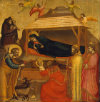Search:: Artists Alphabetically Artists by Country Artists by Century Artists by Movement
Gothic Painting
The word Gothic comes from the word "Goth,". The Goths were fifth-century Teutonic invaders who were looked upon as vicious barbarians.
The Gothic style of painting started in the 12th century. Early Gothic art was characterized by Christian symbolism. The Virgin Mary and Christ changed from the Byzantine iconic form to a more forgiving and approachable figure. The paintings were darkly mystical, infused with an ethereal emotional intensity. Above all Gothic painters were storytellers, narrating both Biblical and secular stories and legends. Altarpieces, portraits and sculptures were meticulously executed, with the concern for perfection typical of the Gothic tradition. Europe was trying to put the memory of the "dark ages" behind it and move on to a more enlightened era. Barbarians no longer ran rough shod, putting entire villages to the torch and slaughtering the local peasants. Without the constant fear of invasion, art and architecture found fertile ground to grow. Gothic painters were not simply anonymous lowly craftsmen, but well respected professionals. They were held in high esteem and often interacted with clergy and wealthy patrons. The Gothic style is a mystical, narrative style of painting. In Gothic Era, people concentrated mainly on the church, God, and a heavenly reward. Life in Medieval Europe was primitive and far more difficult than that of Imperial Rome. Christianity provided an ethical element lacking in previous cultures.In a society of almost complete illiteracy, constant outbreaks of plague, smallpox, leprosy, and the ever present threat of starvation, the beauty of art and architecture was a true sanctuary. All aspects of society was dominated by a single, rigid, restrictive religion. People who did not conform were accused of sorcery or thought to be possessed by the devil and often burned at the stake for "their own good". The average peasant was overcome with devotion and wonderment upon entering the local church and seeing a magnificent altarpiece or statue
The mysticism of the Gothic period imparts a sense of uniqueness and wonder to art. Painters from this time period had a taste for the supernatural and their use of symbols are mysterious hints and glances into the shadowy religious world that lay behind the grinding reality of the times. The style is distinct and clearly different from the heavy Renaissance art produced in in later generation.
Major
Gothic Painters
Hieronymus
Bosch
Require more facts and information about the painter and the artists of the renaissance era? Poke around every nook and cranny of the known universe for information this subject. Search Here
© HistoryofPainters.com If you like this page and wish to share it, you are welcome to link to it, with our thanks.


